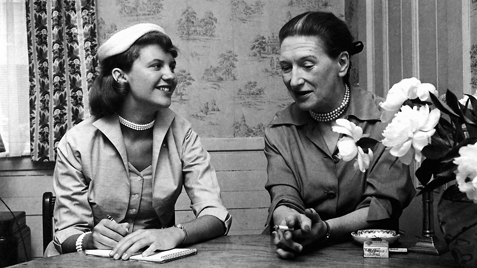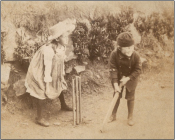

Sylvia Plath reads and interviews Elizabeth Bowen for Mademoiselle, May 1953. Mortimer Rare Book Room, Smith College. © Black Star.
/ Published September 24, 2010
Karen Kukil, associate curator of special collections at Smith, has spent the past 30 years exploring literary subjects “in the round” and the secrets of special collections. In this 2010 talk before the first International Biography Conference, she revealed the rich discoveries she shares with her students while teaching with manuscripts, particularly Smith’s literary collection. Here are excerpts from that talk.
As a curator of the Sylvia Plath and Virginia Woolf collections, I constantly feel like I am looking over the shoulders of these two great writers, watching their minds and hearts spring onto the page in violet ink (in Woolf’s case) and black ink (in Plath’s case). (Plath used a sleek Schaeffer fountain pen to write all her first drafts and a Royal, Olivetti, or Hermes typewriter to complete them.)
In examining the page proofs of To The Lighthouse, we can witness Woolf reading and editing her masterpiece. Woolf corrected the proofs that are now at Smith for the American edition of TTL, which Plath studied as a sophomore at Smith.

Sylvia Plath’s student notes on To the Lighthouse, 1952. Mortimer Rare Book Room, Smith College. © Estate of Sylvia Plath.
In Plath’s copy of To The Lighthouse (now at Emory University with Ted Hughes’s papers), she starred and underlined the final sentence in the dinner party scene in which Woolf says: “Of such moments...the thing is made that endures” (TTL page proof, 163). Plath wrote about the fulfillment, joy, coherence, stability and peace of this scene.
In 1957 after reading A Writer’s Diary and buying a battery of Woolf’s novels, Plath was inspired to write “Venus in the Seventh,” a chapter of her first novel “Falcon Yard,” which was never published. The chapter includes the following passages that are reminiscent of Woolf.
“It was a little like drowning, or the way they claimed it was to drown: you left the husk of oneself with the people you left: each person...would have different husks of her, left in their head, like the laid out mummies at the museum: a presence, dead to the moment, but yet participating now and then, in a terrible, living way in their days and nights.” (“Venus in the Seventh,” page 67, Ted Hughes Papers, Box 140, folder 72, Emory University).
At the end of her sophomore year, Plath switched her major from studio arts to honors English. Inspired by Smith English professor Elizabeth Drew’s teaching and Woolf’s poetic prose, Plath turned her full attention to reading and writing poetry and prose.
Plath wrote “Sunday at the Mintons’” after reading To The Lighthouse. In June 1952, the short story won one of two first prizes ($500) in Mademoiselle’s national fiction contest. The psychological drama was published in the August 1952 issue, which Plath read on the beach at Cape Cod where she was a mother’s helper. Her beach bag that summer also contained Orlando, Woolf’s fanciful biography of her lover Vita Sackville-West, and the Basic Writings of Freud (Letters Home 107).

Sylvia Plath and Elizabeth Cantor, Nauset Beach, Cape Cod, 1952. Mortimer Rare Book Room, Smith College. © Cantor family.
The fiction contest certainly brought Plath to the attention of the Mademoiselle board members who selected her to be the guest managing editor of the college issue the following year. Plath was assigned to interview the Anglo-Irish writer Elizabeth Bowen who also wrote psychological short stories like “The Demon Lover.”
Before interviewing Bowen, Plath checked out at least four of Bowen’s books from Smith’s Neilson Library. Bowen was a good friend of Virginia Woolf during the last decade of Woolf’s life. As Woolf wrote “A Sketch of the Past” she encouraged Bowen to write the memoir of her Dublin childhood, Seven Winters, later read by Plath.
According to biographer Hermione Lee, Woolf admired Bowen’s courage and honesty, while Bowen liked Woolf’s comic exuberance (Lee 642). After one of their meetings in 1940, Woolf read Freud and thought Bowen was repressed.
Childhoods
There are many similarities between the British childhood of Woolf, the Irish childhood of Bowen, and the American childhood of Plath. All lost their idyllic seaside youth because of death and madness.
Bowen left Dublin at the age of seven when her father had a nervous breakdown and committed himself to an asylum. She moved to the south of England with her mother who died of cancer when Elizabeth was 13.
Woolf also lost her mother at the age of 13. After Julia’s death in 1895, the Stephen family never returned to the Cornwall coast for summer vacations.
Plath’s father died when she was 8 and the family moved away from her seaside home in Winthrop to the inland suburb of Wellesley, Massachusetts.
For all three writers, their youth was sealed off “like a ship in a bottle—beautiful, inaccessible, obsolete, a fine, white flying myth,” as Plath wrote in her memoir “Ocean 1212—W.”
Fire and Water
While Elizabeth Bowen thought To The Lighthouse to beWoolf’s most perfect novel, the lyric Waves, which followed, received Bowen’s highest praise and Plath’s most ardent annotations. “In the Waves [says Bowen] what is gradual truth in the other books is ejaculated in a succession of cries” (Collected Impressions 75).
At the end of the Waves, Woolf as Bernard fearlessly flings herself against Death on her proud stead with her “spear couched” and her “hair flying back” like Plath on her horse Ariel, which she rode at dawn on Dartmoor on her thirtieth birthday. As Plath says in the third draft of her defiant poem “Ariel”:
O bright beast, I
Am the arrow, the dew that flies
Suicidal, at one with the drive
Into the red
Eye, the cauldron of morning.

















